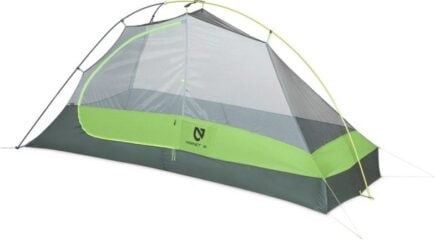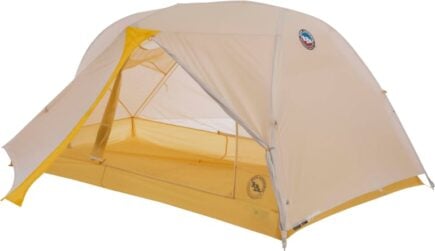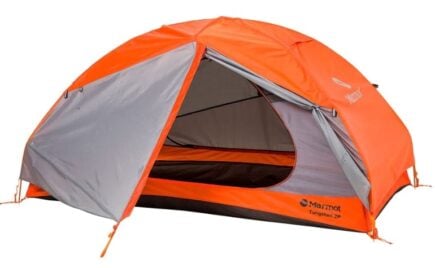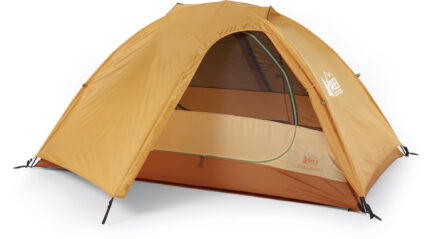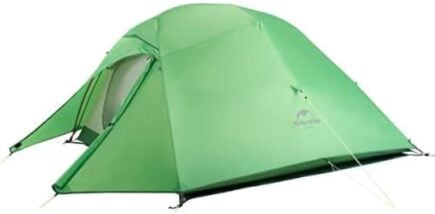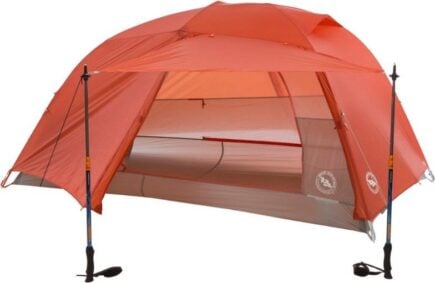Why hike all the way to the top of a mountain only to turn around and rush back to the parking lot before sunset? Bringing along a high-quality hiking tent can turn the afternoon jaunt into an overnight adventure without weighing you down.
Camping out while hiking lets you enjoy the woods in all their glory. The subtle shifts in the breeze turn ominous after dark, and your senses become all the more aware of the beauty (and the beasts) around you. There is just nothing quite like unzipping your hiking tent for a sunrise cup of coffee on a secluded mountaintop.
There’s more than just beauty out in the woods though. The only sure thing about an overnight hike is that mother nature will be unpredictable, so before we can head off on an adventure, we have to trust our gear to get us through a bit of nasty weather.
Your shelter should be versatile and capable and resilient enough to get you through. We don’t all have to invest in four-season tents that can handle snowfall, but your cover shouldn’t collapse at the first drizzle.
Alas, we have chosen the very best hiking tents for all adventures, From ultralight extremes to roomy options that are easy to set-up, we’re taking a microscope to the best tents for hiking trips of all sizes. We’ll show you where the best-in-class options stand out, and where certain tents need to improve, so you can get a better idea of what would fit best inside your backpack.
Quick Answers: What Are The Best Hiking Tents?
- Best Overall Hiking Tent – MSR Hubba Hubba 2
- 2nd Best Hiking tent – NEMO Hornet OSMO Ultralight
- Best ultralight hiking tent – Big Agnes Tiger Wall
- Best Value Hiking Tent – Marmot Tungsten
- Best Ultralight Solo Tent – Vango F10 Project Hydrogen
- Best Hiking Tent under $200 – REI Co-op Trailmade 2 Tent with Footprint
- Best Budget Tent for Hiking – REI Co-op Half Dome SL 2 Plus
- Best 4-Season Hiking Tent – Naturehike Cloud-Up
- Best Hiker & Biker Tent – Big Agnes Copper Spur
- Best Minimal Hiking Tent – Outdoor Research Helium Bivy
Choosing the Right Hiking Tent
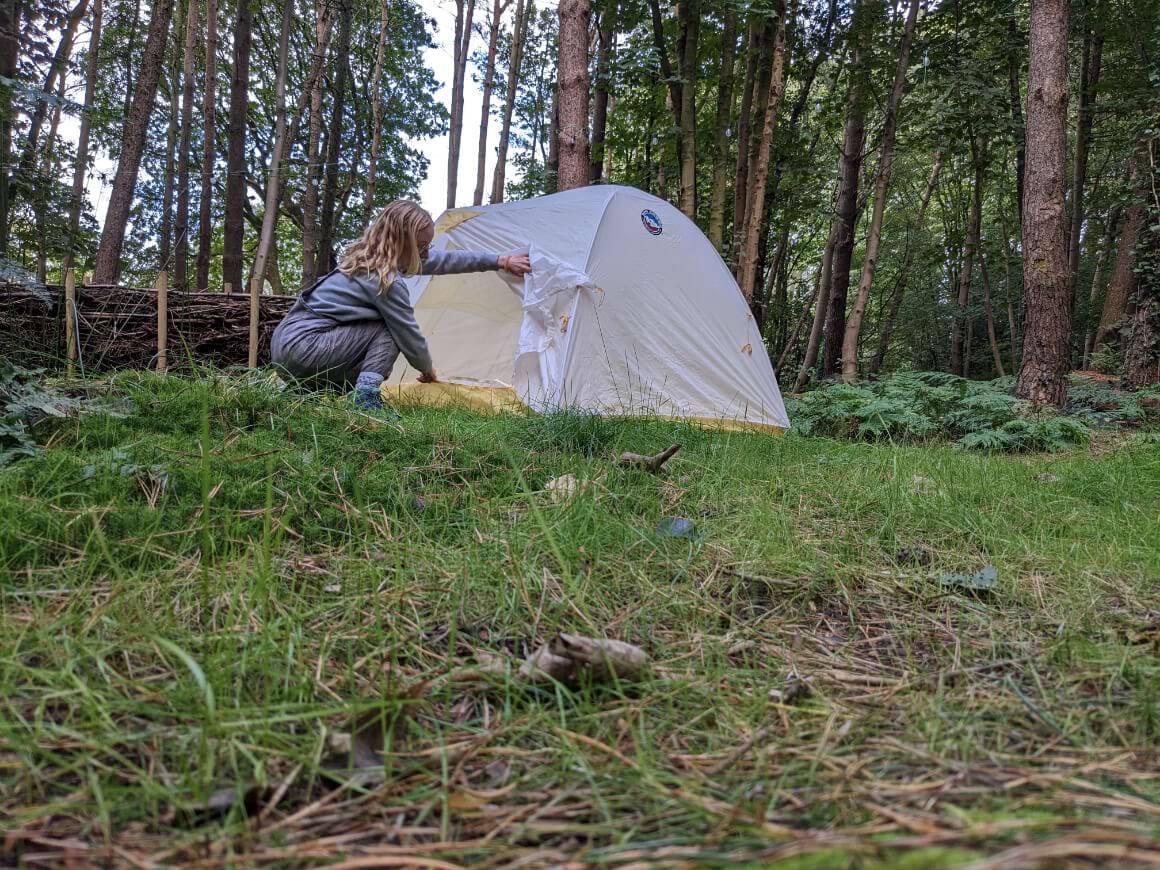
The Broke Backpacker is supported by you. Clicking through our links may earn us a small affiliate commission, and that's what allows us to keep producing free content 🙂 Learn more.
Choosing a tent is always a tricky business and this is especially true when looking for a hiking tent. Let your hikes determine your tent. You’ll have to carry your tent on your back every step of the way, as well as food, water, and everything else you need for the weekend. A hiking trip is no beach week. You can’t pack everything you can fit in the car if you plan on walking a few miles to your campsite.
That means you need to know how far you’re going and what kind of route you’ll be taking to choose the right kind of tent for you. Extra weight may be acceptable if the campsite isn’t far from the parking lot, but climbing a mountain can make one kilometer take an hour, and one kilogram feel like fifteen.
We’ve laid out three factors that will help define the right hiking tent for your travel style. Build your unique combination of weight, endurance, and affordability, and let that show you to your tent.
There is no tent on the market that leads the way in every category, which means no hiking tent is perfect for everyone. Visualize where your tent will take you and what weather you’ll be up against, and let the right tent help you get out there. It’s certainly what I did when recently picking out the best hiking tent for Australia, where I spent 6 weeks camping not too long ago.
Size
Every serious contender is always looking to drop weight. The tents on our list weigh anywhere from 700 grams to 2.5 kilos. Consider anything under 1.5 kg an ultralight hiking tent even though some heavier ones will try to pass themselves as Ultra-light.
Each year, tent weight hits new lows. To shave those last precious ounces, companies use high-grade materials that can sometimes be fragile and certainly won’t be roomy. That means that weight isn’t the only thing you’ll have to take into account.
For any longer hikes, weight should undoubtedly be a deciding factor, but don’t forget about checking the interior height and floor space. Any tent on our list will fit inside most 40 Liter backpacks, but not any two-person tent will actually fit two people comfortably.
An unspoken rule of tent marketing is that two-person tents are often best suited for one. We recommend any hiking partners who plan to spend plenty of quality time underneath the nylon look towards a three-person tent to provide enough room to stretch. Of course, one man tents are the easiest and lightest to carry if you are out on a solo trip.
Durability
The wind does not care how light your tent is. If you plan on hiking rain or shine, there is no price too steep to pay for guaranteed protection. No matter what you had planned, you’ll eventually walk into some foul weather if you wander long enough. Your tent will be exposed to wind, rain, sun, and time.
Plenty of tents make promises, but only a few stay ready to go a decade down the line. Make sure to look into warranty services and repair agreements before committing to anything.
REI has the best purchase protection policies in the business, and they tend to carry most leading tent brands. If you plan on purchasing a high-end tent, the savings you’ll receive from your co-op membership on this purchase will offset the cost of becoming a member, giving you free entry into a world of outdoor gear benefits.
Most of the tents on our list are three-season hiking tents. The difference between three and four season tents is more than just warmth. Think of three-season tents as light models that can handle ordinary storms and four-season tents as heavyweight options that trap heat and protect against stronger winds.
The lightest four-season tents won’t weigh less than 2.2 kgs, making them more of a niche camping option than a universally used design. If you aren’t planning on camping in the snow or a tropical storm, you’ll probably be just fine in a three-season tent, and your back will thank you.
However, it only takes one night in the extreme cold or extreme weather to make the extra weight of a fully protective tent worth the heavy load. Tent producers are constantly pushing the boundaries of lightweight durability, but you can’t improve one without taking away from the other at a certain point.
Price
It’s fun to daydream about a robust, weather-resistant tent that packs down to less than a one-liter water bottle, but it’s way less exciting to type in your credit card information.
Adventurers have told companies they’re willing to pay top dollar in exchange for high-performance tents built to last. The fancier the technology and lighter the scales, the higher the price. The best tents on our list aren’t cheap, but they are worth every penny.
We don’t think there are many tents under $150 that will allow you to push yourself to new heights while hiking. Beginners or hikers not looking to walk more than an hour to their campsite will be OK paying between $200-300 for their tent, depending on what you want out of it.
Tents that can hang with the most demanding adventures will cost $300-500. Anything weighing less than two kilos is well worth that hefty investment. The MSR hubba hubba, for example, is so light and so roomy I can throw it in my backpack whether I’m hiking, traveling, or heading to a festival for the weekend. Having that versatility is priceless.
MSR Hubba Hubba 2
- > $449
- > Ultralight tent with a splash of headspace
- > Built to last a decade
NEMO Hornet OSMO Ultralight
- > $329
- > Incredibly lightweight
- > Comes in regular and elite models
Big Agnes Tiger Wall
- > $399
- > Cross pole creates headspace for two
- > Extra pockets and two doors
Vango F10 Project Hydrogen
- > $600
- > Packs more petite than a water jug
- > Schrader valve inflates a beam that increases headspace
REI Co-op Trailmade 2 Tent with Footprint
- > $159
- > Roomy hiking tent
- > Affordable tent
REI Co-op Half Dome SL 2 Plus
- > $279
- > Four vents
- > Best interior space around
Naturehike Cloud-Up
- > $159
- > All-weather aluminum poles
- > Lightest three-person hiking tent on amazon
Big Agnes Copper Spur
- > $449
- > Comes in loads of different sizes
- > Protection against wet and hot weather
Outdoor Research Helium Bivy
- > $199
- > Flooring is durable and built for bad weather
- > Overhead pole provides ventilation
The Best Hiking Tents in The World Today
Whether you want ultralight features, durable materials, or extra space, we’ve got some great tent options for trips big and small.
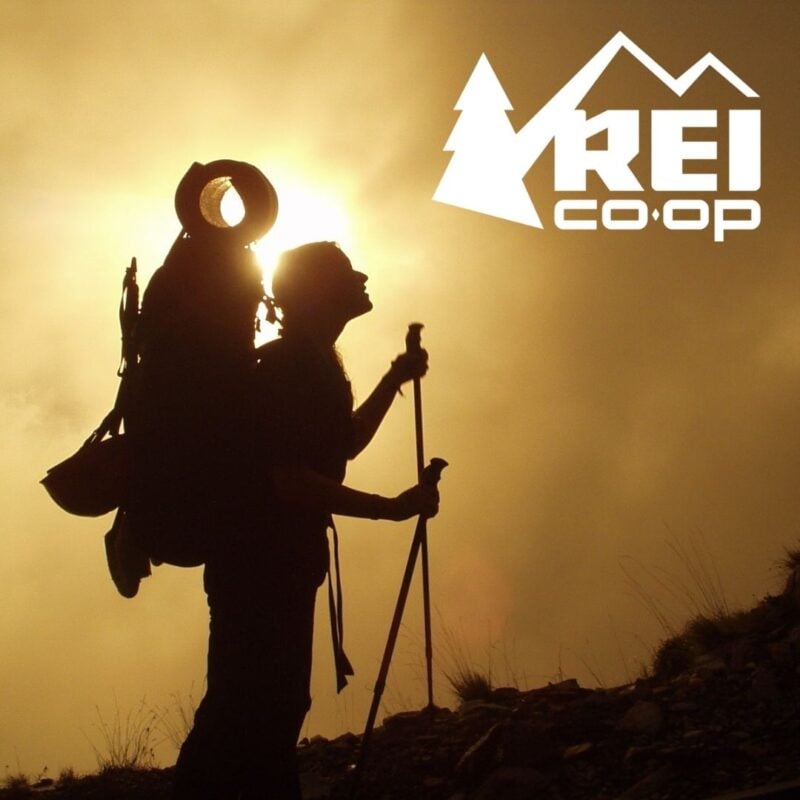
REI is one of America’s biggest and most-loved outdoor gear retailers.
Now, for just $30, get a lifetime membership that entitles you to 10% OFF on most items, access to their trade-in scheme and discount rentals.
Join REI Today!#1 – Best Overall Hiking Tent – MSR Hubba Hubba 2
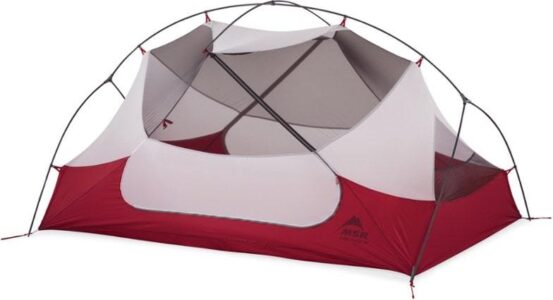
MSR Hubba Hubba 2 is our top pick for best overall hiking tent
- Weight (kg): 1.75
- Packed Dims (cm): 46 x 15
- Price: $449
I don’t care where you’re going; your trip will be better off with a bit of Hubba Hubba. You can fit this fine tent from MSR in packs as small as 22 liters and stay dry and cozy no matter the weather.
While this tent may seem like a heavy investment, we honestly think it’s the best two-person hiking tent on the planet. The technology packed inside this bad boy is worth its extraordinarily lightweight in gold.
A unique pole set-up and untapered walls allow two people and two backpacks to stay dry inside. This kind of interior space is incredible for a tent that falls into the ultralight category. Quick, warm trips can shed the tent body and hike with less than a kilogram of tent in their bag.

The Hubba Hubba has been around for years, so you can always find deals on older models, but every year has brought improvements into this carefully laid out space. The new decade brought improved weather resistance, and aerospace-grade poles dreamed up by Easton Sports.
You can find lighter tents, and you can find more spacious tents, but you’ll have a tough time finding a tent that ranks as highly in both categories, all for less than $500.
Personally, this was my go-to best hiking tent for Australia recently and I just loved it in every way. The weather in Far North Queensland can be wet, let me tell you!! This bad boy kept me and my gear bone dry even through the wildest storms. I also found it to be light enough for multi-day hikes and enjoyed the simple set up too.
- Great for loads of different scenarios
- Ultralight tent with a splash of headspace
- Built to last a decade
- Not the easiest tent to set up
#2 – 2nd Best Hiking Tent – NEMO Hornet OSMO Ultralight
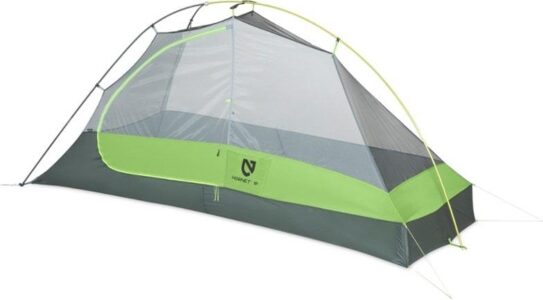
Our top pick for 2nd best hiking tent is NEMO Hornet OSMO Ultralight
- Weight (kg):.90
- Packed Dims (cm): 48 x 11
- Price: $329
This Nemo Hornet should satisfy the needs of many hikers who demand high performance out of their gear. Right away, this lightweight tent stands out on the spec sheet. Whether it’s your first foray into an ultralight tent or your fifth, the weight of this tent is sure to catch your attention. I’ve packed burritos that weigh more than this shelter.
The packability gets boosted even further if you decide to split the tent up between two hikers to further reduce weight on longer trips. The tent bag splits into two parcels weighing a half kilo each. When you’re going extraordinary distances, every ounce matters.
Make no mistake; The Hornet is not built for comfort, It’s built for speed.
This is a classic ultralight tent that can technically fit two people in, but you’ll be getting up close and personal. It’s better off being used as a one-person tent unless ounces are the top of your priorities.
On warm nights you can strip off the rain fly and enjoy panoramic views without getting bit. For damper evenings, solid poles and two protected vestibules keep everyone dry.
It’s one of the lightest hiking tents we could find, perfect for campers looking to cut weight.
If that’s still too much tent for you, check out the Nemo Hornet Elite, which provides the same levels of comfort, albeit in a bit more fragile shell, to shave off precious ounces.
The team loved this tent, especially when it came to multi-day hikes. In fact, one of our team took it out on a 50+ mile hike over a week and they found it great to carry on their backs as well as in use. They also came across some pretty wild weather on their trip and the tent more than stood up to anything Montana’s peaks could throw at it. They also commented that it was great for condensation prevention.
- Incredibly lightweight
- Committed to high-performance features
- Comes in regular and elite models
- 2 people will really get to know each other in this tent
- Technically advanced lightweight features are fragile
#3 – Best Ultralight Hiking Tent – Big Agnes Tiger Wall

Big Agnes Tiger Wall is our top pick for best ultralight hiking tent
- Weight (kg): 1.13
- Packed Dims (cm): 46 x 14
- Price: $399
Any list of the best hiking tents in the business has to offer up something cooked by Big Agnes. On today’s menu, the company is serving up a unique cross pole design that provides precious centimeters of headspace.
This simple bar gives the Tiger Wall an edge for two-person ultralight tents, and designers ran with it, adding extra doors and pockets. A few additional mesh pocket bags may not sound like a huge deal, but I don’t know if there’s ever been a time where I’ve had too many pockets.
While there is room for two people to sit up straight, this tent is still ultralight first. You won’t find much space for cards on a rainy afternoon.
Sure, you’ll be a bit cramped, but at least you’ll be dry. The tent holds strong through most casual rainstorms. However, we have noticed some weak points in the rain fly system, mainly just wonky zippers. Campers braving foul weather should bring along a footprint and a cup of hot choccy.
The team told us they appreciated the white colour of the tent for keeping things cool, which was especially useful for summer trips. They did say the only downside to that was that it did take a while to dry out when it came to the condensation build-up when not camping in super sunny areas. In terms of weight, they were super impressed and felt it has pretty much shed as much unnecessary bulk as possible.
- Cross pole creates headspace for two
- Extra pockets and two doors
- Went for lightweight over fully weather-resistant
#4 – Best Value Hiking Tent – Marmot Tungsten

Marmot Tungsten is one of the best value hiking tent
- Weight (kg): 2.38
- Packed Dims (cm): 53 x 18
- Price: $214
If kilos are not your biggest concern, have a good time in this roomy tent. The Tungsten is a hiking tent done with style and comfort in mind. Two large doorways and a lot of zippered mesh will get you closer to the sunrise on nights you don’t need a rainfly.
Marmot added on a footprint to further protect your investment. If you’ve been flirting with overnight hiking, this tent could make you fall in love. This tent isn’t trying to do anything crazy, just bring a fresh breath of affordability into an industry crowded with high-cost options.
Car campers and trips without too much walking can throw this hiking tent in your trunk or backpack and have it set up in plenty of time to cook dinner before dark. Marmot provides a tent that takes high-class specs and adds on an extra splash of affordability. At over two kilos, It’s one of the heaviest tents on our list, so make sure you understand where your priorities lie.
The bottom line is this: There’s plenty of sleeping space, decent weather resistance, and the tent is light enough to take on shorter hikes, all at an incredible price. Most nights won’t demand anything more than this.
One of the points where the team felt this tent really stood out amongst the competition was the ease which it took to set up. They also loved the inclusion of the two vestibules which meant that each occupant had an entrance to the tent so they didn’t need to crawl over each other (unless they wanted to!) and had space for their bags and boots.
- Most affordable option on our list
- Oodles of headspace
- Comes with a footprint
- Heaviest tent on our list
- Doesn’t pack in many ultralight features
#5 – Best Ultralight Solo Tent – Vango F10 Project Hydrogen
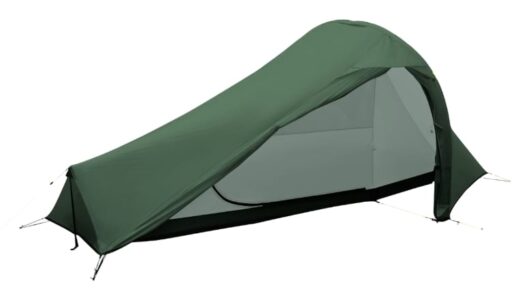
Our top pick for best ultralight solo tent is Vango F10 Project Hydrogen
- Weight (kg): .70
- Packed Dims (cm): 20 x 12
- Price: $600
I had to check to make sure Project Hydrogen wasn’t also the name of a psyop, and you’ll have to double-check you packed the Vango F10, as it’s so light you might not notice it. Vango has upwards of 100 different tent styles in their current catalog, suitable everywhere from the backyard to Everest. This particular solo tent is all about packability.
First of all, it’s a tent without many poles. Just one carbon upright pole combines with a Schrader valve to inflate your home. Loved by bikepackers (it’s a great bike packing tent) and long trekkers, this single inflatable beam runs through the center of the tent to provide your headspace. It’s probably easier to inflate with a pump fully, but your mouth can get the job done unless you’re sleeping in high winds.
Cutting out the poles makes this tent pack down smaller than a one-liter water bottle. With a size that small, don’t expect to find a full kitchen inside. This tent isn’t a huge step up from a bivy sack, but it should allow just enough space to store you and your backpack comfortably.
You’ll be happy you have those precious inches of headroom, especially considering this tent doesn’t weigh any more than most bivies either. This one-person ultralight tent makes a great companion for touring adventurers who plan to be on the go more than at the campsite.
The team were blown away by just how small and light this bit of kit was! They loved the blow-up method of pitching the tent and felt it made it both super easy but also avoided any issues with broken tent poles. They did however feel that with it being super light, it does need to be treated with a bit of extra TLC if you want it to last. Having said that, it did stand up well to some challenging weather.
- Packs more petite than a water jug
- Only uses one pole
- Schrader valve inflates a beam that increases headspace
- Not much bigger than a bivy
- Tough to find in the Americas

Do You Want to Travel FOREVER??
Pop your email in below to get a FREE copy of ‘How to Travel the World on $10 a Day!’.
#6 – Best Hiking Tent Under $200 – REI Co-op Trailmade 2 Tent with Footprint
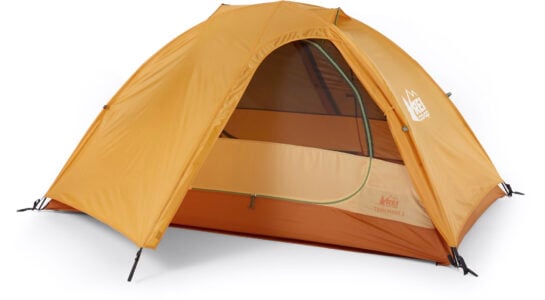
Meet the best hiking tent under $200: REI Co-op Trailmade 2 Tent with Footprint
- Weight (kg): 2.55
- Packed Dims (cm): 46 x 20
- Price: $159
You don’t want to go cheap on sleep. That being said, not every hiker needs a $500 tent in their backpack. This tent provides enough to keep you warm and dry three seasons a year without getting fancy.
If you’re not planning on heading out for weeks at a time and camping no matter the weather, REI tents consistently have provided great value at an affordable price that provides lush accommodation at the end of a great day’s hike. With the included footprint, you won’t have to worry about any add ons. Once you’ve got your tent, you can start planning your next adventure!
The Trailmade two is a modern tent that takes the tried and true two-pole free-standing design with two poles and a third pole to attach your rain fly. It’s as easy to set up as any tent can be, and the wide rain fly opens up enough vestibule space for two bags and a few pairs of boots.

Sure, it’s heavy for longer hikes, but there’s no such thing as a $179 tent that won’t be irritating to lug from peak to peak. A roomy interior, two big doors, and loads of pocket space provide a great base camp tent.
What really sets this tent apart from other budget tents is the quality of materials used and the customer service. Most cheap tents don’t come with warranty options at all, but REI does things differently. Try out the tent, and if you don’t love it, you can return it with no questions asked for an entire year.
One member of our team ended up enduring 6 straight days of rain … we did tell them not to go camping in the North West of England, but would they listen?! So when it comes to testing out whether or not this thing is waterproof, well, we’ve got you covered on that front! They also relayed back to us that it was really easy and quick to get set up.
- Roomy hiking tent
- Most affordable tent on our list
- REI return policy makes your purchase secure
- Not a high-performance tent
- You’ll notice it in your bag after a few kilometers
#7 – Best Budget Tent for Hiking – REI Co-op Half Dome SL 2 Plus
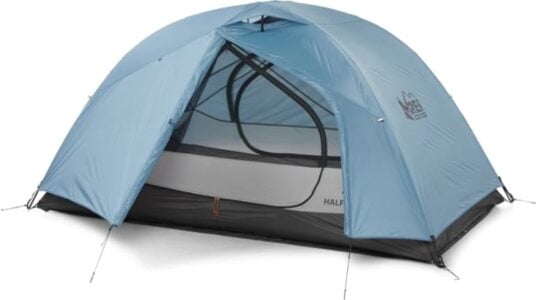
REI Co-op Half Dome SL 2 Plus is our top pick for the best budget tent for hiking
- Weight (kg): 2.14
- Packed Dims (cm): 52 x 18
- Price: $279
The half dome plus maybe a bit more expensive than REI’s Trailmade 2, but it adds on improved weather resistance and provides a staggering 3.5 square meters of floor space. Nobody loves to spend an afternoon in a tent sheltering from the rain, but the Half Dome 2+ will make it way easier to wait out the storm.
This extra space really comes in handy, but it will tack on a few grams, so we recommend splitting up the tent bag between two hikers if you plan on walking a few hours to your campsite.
These tent zigs where most others zagged by focusing on durability, weather resistance, and interior living over lightweight status. It’s not an ultralight tent, but it has proven more than capable of providing a legitimate waterproof shelter. Tack on a footprint, and your tent will stay in shape through a bit of trouble.
The Half dome series has been one of REI’s best-selling tent models for a long time, so the HD2+ had big shoes to fill. You can take the plus to mean “plus-size.” These tents are roomier than the competition, pack in full-view mesh and four vents to keep things cool, and won’t break your budget.
The team loved the weight-to-durability ratio of this tent, they felt it was light enough to carry around on long trips and yet it felt much more hard wearing than other models. It also stood up to some pretty epic thunderstorms out on the road and never had any issues. The taller folks were also impressed by the size of the footprint of this tent too.
- Best interior space around
- Four vents
- At the crossroads of affordable and performance
- More space means more weight
- Tall interior can shake in high winds
#8 – Best 4-Season Hiking Tent – Naturehike Cloud-Up

Meet the best 4-season hiking tent: Naturehike Cloud Up
- Weight (kg): 2.2
- Packed Dims (cm): 45 x 15
- Price: $159
This relatively unknown camping brand provides an excellent pick for an all-weather, three-person tent that stays lightweight if you’re willing to take a risk. 2.3 kgs won’t rank as one of the lightest options on our list, but this is a tent built for three, so we expect a bit of extra weight alongside extra space.
Naturehike is based out of China, and it remains to be seen if this young company is a serious contender in the outdoor industry or another knockoff brand cutting corners to provide tents that promise to do it all at a low price but crumble under pressure. As long as Naturehike holds firm, plenty of weather resistance and warmth are built into this protective tent option.
So far, we haven’t noticed any red flags. Durable 20D nylon makes up the mesh and rainfly, and the poles are made out of aluminum instead of ultralight carbon fiber, which provides a more user-friendly experience and holds strong in high winds. You don’t have to give this tent any special treatment like you would an ultralight model.
The regular Cloud-Up model does not fare well against condensation. The double-wall tent is built for foul weather but doesn’t allow ventilation to keep the air moving on stagnant nights.
An upgraded model takes care of that problem by providing a full view mesh canopy and air vents that will have you sleeping under the stars on warm nights.
Our guys usually want to get comfy as soon as they get to the campsite and they loved that it only took them 5mins and 31 seconds to put this tent up, yes, they timed themselves! They felt it was also one of the most well-ventilated tents on the market, but that this might also make it a little drafty when the super cold weather comes in. They also said it felt pretty spacious for two people and plenty of gear, though 3 might be a push.
- All-weather aluminum poles
- Lightest three-person hiking tent on amazon
- Amazing specs
- Unproven company
- Condensation struggles on warm nights
#9 – Best Hiker & Biker Tent – Big Agnes Copper Spur
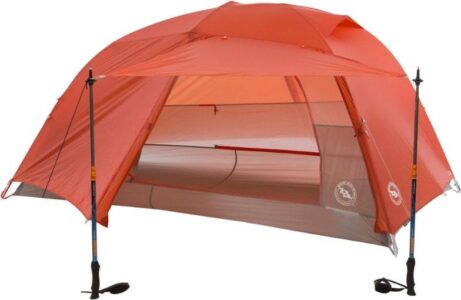
Big Agnes Copper Spur is one of the best hiker and biker tent
- Weight (kg): 1.41
- Packed Dims (cm): 50 x 15
- Price $449
Stretch out at the end of a long day’s walk or ride in this roomy, lightweight tent. The Copper Spur comes in sizes that fit up to three, or preferably, two people with plenty of room to spare. Squeezing three in would be tight, as the traditional two-pole setup doesn’t provide loads of headroom.
This traditional X shape makes the set-up of this tent a breeze. After a few practice runs, one person could get this tent up in a hurry, even if you ride through the sunset. Once it’s standing, stretch out your stakes to provide a tremendous waterproof vestibule shelter.
The double-wall build on this Big Agnes tent means your fly and the tent body won’t touch in the rain. Once the weather calms down, you can open up your rain protection into an awning space that will open up your living space as long as you have a set of trekking poles.
All the freedom brought by the Copper Spur’s versatility is priceless. You can open up your doors and awning space to maximize ventilation or protection, which means this tent provides a great space to end a day of biking, rain, or shine.
Our team came back to me and told me the tent was “bombproof”, so it’s safe to say they were pretty blown away by the quality of this tent. The addition of the trekking pole awing was also a winner for the team, they felt it was a genius use of weight and space. Overall, they felt the tent balanced weight and performance perfectly.
- Comes in loads of different sizes
- Protection against wet and hot weather
- Only vestibules require staking
- Even the largest size is a tight fit for three
- Poles are bulky to pack
#10 – Best Minimal Hiking Tent – Outdoor Research Helium Bivy
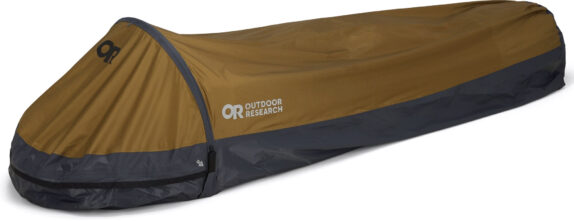
Our top pick for best minimal hiking tent is Outdoor Research Helium Bivy
- Weight (kg): .79
- Packed Dims (cm): 30 x 13
- Price: $199
Heading out on your own path? Withstand harsh winds and snow flurries without sacrificing ventilation with Outdoor Research’s newest Bivy. Bivies won’t come close to offering the same comforts of a tent, but at that low weight and price point, you may not care.
This all-season Bivy has a robust Nylon floor and can function as a serious cocoon on colder nights. When the weather clears, unroll the structured visor for some ventilation without getting wet.
At every step, designers gave this bivy an extra bit of comfort generally sacrificed in the gear category. A great example of this is the extra Centimeters at the end of this Bivy will let even tall hikers comfortably fit their gear in the foot.
Make no mistake – this is no night at the Hilton. Like any Bivy, you won’t find any room to stretch out inside this option, which isn’t much more than an extended raincoat for your sleeping bag.
Minimalists and quick adventurers who want to wake up at the crag can stay cozy and dry inside this all-season bivy.
A bivy is of course a bit of a niche product when it comes to camping, some people swear by them but for the majority of the team this was a new experience. So with that in mind, they were pretty impressed by how spacious it felt given how light it was. They felt it was also super easy to set up and the door system allowed a good level of ventilation too.
- Corner guylines help wind resistance
- Flooring is durable and built for bad weather
- Overhead pole provides ventilation
- Can’t even sit up inside
- Condensation can be a problem
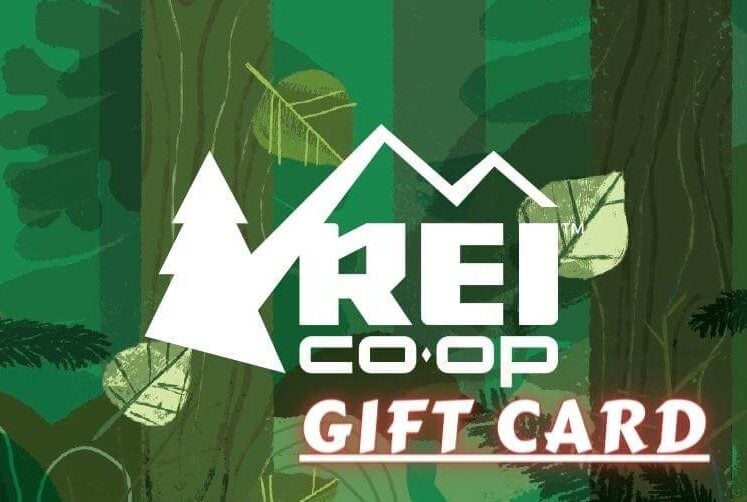
Now, you could spend a fat chunk of $$$ on the WRONG present for someone. Wrong size hiking boots, wrong fit backpack, wrong shape sleeping bag… As any adventurer will tell you, gear is a personal choice.
So give the adventurer in your life the gift of convenience: buy them an REI Co-op gift card! REI is The Broke Backpacker’s retailer of choice for ALL things outdoors, and an REI gift card is the perfect present you can buy from them. And then you won’t have to keep the receipt. 😉
Buy on REI!| Name | Capacity (person) | Floor Space (inches) | Weight (lbs) | Price (USD) |
|---|---|---|---|---|
| MSR Hubba Hubba 2 | 2 | 4176 | 3 lbs. 4 oz. | 549.95 |
| NEMO Hornet OSMO Ultralight | 1 | 3211.2 | 2 | 399.95 |
| Big Agnes Tiger Wall | 2 | 4032 | 2 lbs 8 oz | 449.95 |
| Marmot Tungsten | 2 | 4334.4 | 5 lbs 14.2 oz | 249 |
| Vango F10 Project Hydrogen | 1 | – | 1.54 | 600 |
| REI Co-op Trailmade 2 Tent with Footprint | 2 | 4464 | 5.62 | 159 |
| REI Co-op Half Dome SL 2 Plus | 2 | 4860 | 4 lbs 11.5 oz | 230.29 |
| Naturehike Cloud-Up | 3 | 6048 | 4.85 | 159 |
| Big Agnes Copper Spur | 2 | 4176 | 3.11 | 549.95 |
| Outdoor Research Helium Bivy | 1 | – | 1.74 | 199 |
How and Where We Tested To Find The Best Tent For Hiking
The only way to really test a tent out properly is to actually take it out and spend a few nights in the great outdoors in it! Sooooooo, that is exactly what the intrepid explorers here at TBB did! We gave each team member each one of the tents and they took them out in a variety of different weathers, climates and locations.
In order to fairly and consistently assess and compare them to each other, our testers applied the following metrics;
Packed Weight
Printed weight will only tell you so much, the real test comes when it’s packed up and on your back 5 hours into a hike in the pissing rain! Know what I mean!? So we assessed each item by how it felt rather than what the manufacturers told us. Of course, the lighter a tent the better it feels!
Packability (Packing and Unpacking!)
One of the most important factors when picking out a tent is how easy it is to pack and unpack. It’s all well and good buying a tent with a fancy brand or saving a few dollars on the cheapest option. But when you’re in the driving rain on the top of a mountain, you’ll want something that doesn’t require a degree in engineering to pitch and un-pitch!
So, our brave and bold testers went the extra mile just for you and battled some really awkward tents in order to sift through the crap and bring you the gold!
So, our team awarded extra points for those tents that were easier to pack and unpack!
Warmth, Waterproof and Ventilation
You never really know a tent until you spend a night under the canvas (or tarp or whatever it’s made from!) This is when you really find out if that temperature rating stacks up! No one is having fun spending a night in frigid conditions and equally, a sweaty evening in a tent without sufficient ventilation isn’t great either!
So each of our testers were told to look specifically at the warmth and ventilation capabilities of a tent. Of course, they took into consideration the sleeping bags they were using at the time too.
Another important factor in testing out each tent is waterproofing. Whether you’re looking for the best hiking tent for Australia or a rainy weekend in Leeds, you’re gonna want that thing to keep your gear dry! So we did our rain dances and hoped for a downpour, and if it didn’t happen, we poured a good old bucket of water over them instead!
Spaciousness and Comfort
A hiking tent isn’t going to be the most spacious accommodation on the planet, but some seem to maximise their space better than others, or just “feel” bigger. Again, the best way for our testers to get a sense of how roomy and how comfortable they felt was to spend a few nights in them with all their gear.
Build Quality and Durability
A hiking tent has to cope with some serious weather, from gale-force winds to overnight downpours … you don’t want it to be flimsy! Equally, it’s a tent that will be used night after night on multi-day trips at least a few times a year, so you don’t want something that is going to give up on you when the going gets tough.
Our testers looked at the build quality of each tent by inspecting the seam sewing, the thickness of the fly sheets, the hardiness of the zippers and assessing the overall feel of the tent.
They also had each tent for a good few weeks on most occasions so they were able to see how durable each one was on longer trips and on multiple outings.

Our GREATEST Travel Secrets…
Pop your email here & get the original Broke Backpacker Bible for FREE.
Last Word On The Best Tent For Hiking
You don’t need to drop a thousand dollars for appropriate shelter on the go, but you shouldn’t settle for some cheap tarp that crumbles at first sight of rain, either. Depending on your needs, $150-400 is enough to stay warm and dry when it comes to picking a best hiking tent for Australia and beyond.
If you expect to push your tent to the limits, give it a chance to succeed by investing in high-quality protection. You wouldn’t cut corners when laying down the foundation for your house, and you shouldn’t take chances with extreme weather and cheap tents.
Hiking is not something that you should do with a strict time limit. Any tent on this list weighs less than three kilos and can be quickly set up and stowed away, so you can focus on having fun.
Everyone’s hiking checklist is different. While we can’t cover every single tent on the market, we tried to show off something for everyone. The right gear will take you further, and we’re here to help you two meet each other and start hiking.
Whether you’re just getting your feet wet or gearing up to thru-hike, the perfect tent for your next hiking trip is somewhere on this list.
Did we help narrow down your choices? Or did we miss your favorite tent for hiking trips? Let us know in the comments below.
Buy Us a Coffee!
A couple of you lovely readers suggested we set up a tip jar for direct support as an alternative to booking through our links. So we created one!
You can now buy The Broke Backpacker a coffee. If you like and use our content to plan your trips, it’s a much appreciated way to show appreciation 🙂



